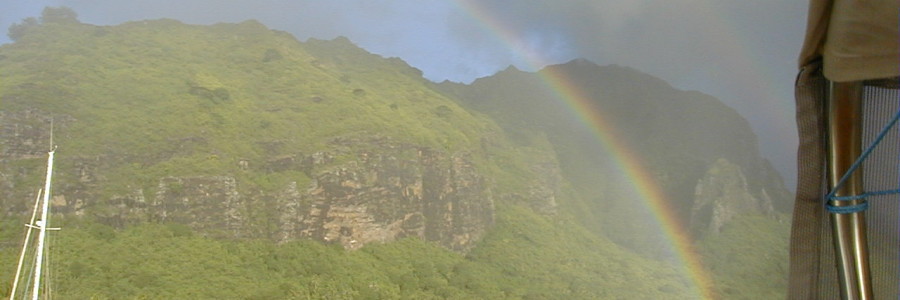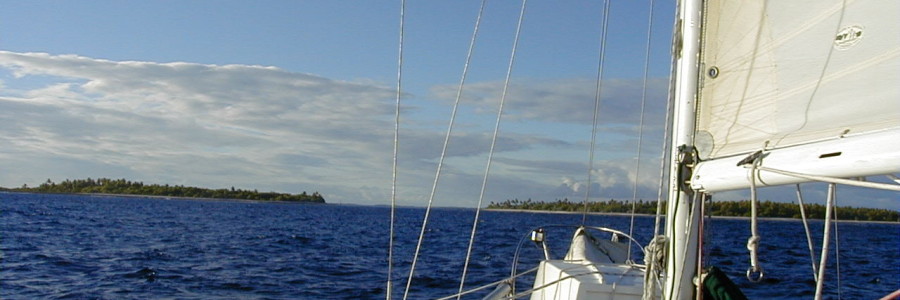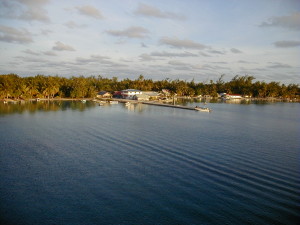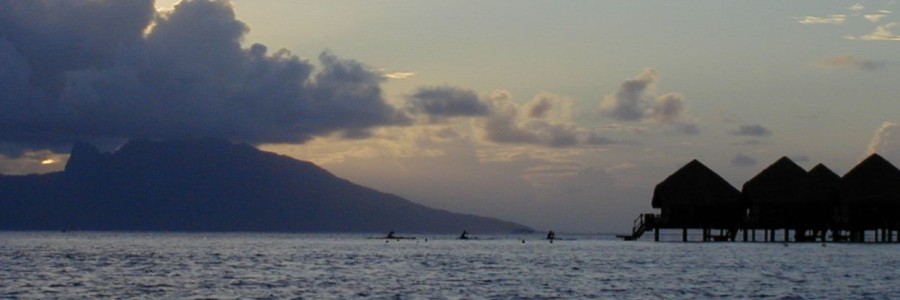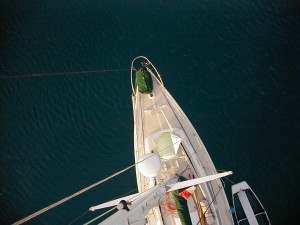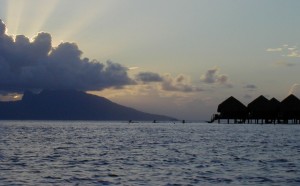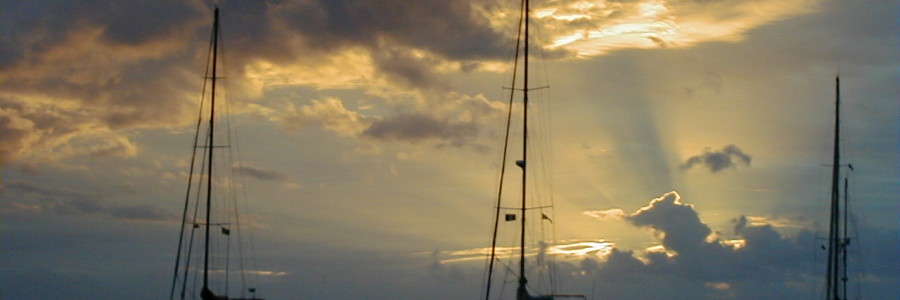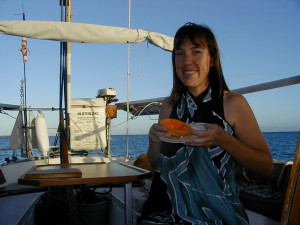 So, where have Todd and Ellen been? In a nutshell, we’ve been having great sailing, fun adventures and haven’t been near an internet café for quite a while. We still aren’t near internet access. Believe it, or not, but there are some places in the world that the internet hasn’t invaded. Aitutaki Island is one of those places. The reason is as mundane as a phone company monopoly and high long distance rates. So, while we cannot yet check our email, sorry if our box is full, we are able to send a trip log out.
So, where have Todd and Ellen been? In a nutshell, we’ve been having great sailing, fun adventures and haven’t been near an internet café for quite a while. We still aren’t near internet access. Believe it, or not, but there are some places in the world that the internet hasn’t invaded. Aitutaki Island is one of those places. The reason is as mundane as a phone company monopoly and high long distance rates. So, while we cannot yet check our email, sorry if our box is full, we are able to send a trip log out.
We haven’t written since Moorea. We are now about 500 miles further West and have visited four more islands.
At Moorea we discovered the convenience of a reliable outboard. In this gorgeous spot, our outboard was sick and finally died.
The planned activity for the morning was snorkeling with the rays. Our friends, Nancy and Tom of Equinox, were going also. Gosh, the rays are about three miles away, we’d better get the outboard working. Todd opened it up, fixed some broken springs, put it back together with a little help from your’s truly, and it was running like a champ. We packed a gear bag: snorkels, masks, sunscreen, munchies.
“Should I throw in the handheld radio?” asks Todd.
“Sure, why not?” I answered.
And away we went. Mandolin was on the east side of the pass of Opunohu Bay and the snorkel spot was a few miles west of the pass. The wind and swell was out of the east and the pass was a bit lumpy. “We’re going to be bashing into it on the way back,” I thought. On the other side of the pass, behind the reef in beautiful turquoise water once again, five foot high posts marked the dinghy channel. While we connected the dots, several tour boats from the many resorts were doing the same. One or two came way too close and almost swamped poor little Abu.
“&*%$#,” I said while the tourists waved.
Halfway there, Tom and Nancy zipped by us in their inflatable and large outboard. Small and simple is good, but big is often fast.
We followed the directions we had been given. A few tour boats were already there making it easy to find the rays. The spot was just off a deep channel in about four to six feet of water. About twenty snorkelers from the tour boats were swimming above ten to fifteen rays. The rays skimmed just above the surface of the sand. I wondered why they stayed near the snorkelers until I saw raw chicken in the hands of a few. A ray might settle on the sand for a moment, but would then be off and moving around soon thereafter. I wondered if they were agitated with all these swimmers in the water. I had never seen so many rays swimming about all at once.
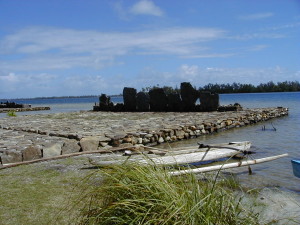 Soon, I found a frozen chicken pieces bag adrift in the water with a piece of chicken in it. I put the bag in our dinghy and swam back to the rays with my bait. It’s one thing to have a ray want what is in your hand and another to have a shark interested. From up out of the deep channel swam a small white tip reef shark with slow, lazy movements. I dropped my piece of chicken and swam away from it. I didn’t notice if the shark ate it or not. Todd and I caught site of the shark a few more times. It seemed disinterested in the snorkelers and the rays. We watched as it slowly disappeared again down into the deep water of the channel.
Soon, I found a frozen chicken pieces bag adrift in the water with a piece of chicken in it. I put the bag in our dinghy and swam back to the rays with my bait. It’s one thing to have a ray want what is in your hand and another to have a shark interested. From up out of the deep channel swam a small white tip reef shark with slow, lazy movements. I dropped my piece of chicken and swam away from it. I didn’t notice if the shark ate it or not. Todd and I caught site of the shark a few more times. It seemed disinterested in the snorkelers and the rays. We watched as it slowly disappeared again down into the deep water of the channel.
We putted back toward Mandolin with our funny little outboard. There is a town on the west side of the pass with a nice little harbor for local boats and we stopped for bagettes, veggies and ice cream.
Time to face the windy lumpy pass. We would be motoring right into it. Except that we wouldn’t. The outboard decided that it was time to go on strike. A few pulls produced the undesirable result of the spring Todd had fixed that morning breaking again. I’ll spare you the details of our attempts to fix since they were all to no avail.
“I guess we’d better start rowing,” I said.
Todd had hurt his back on the way to Papeete. The chiropractor that fixed him all up said that he shouldn’t row for awhile along with not lifting anything heavy.
I rowed as strong as I could into the seas and wind. Abu seemed to go up and down more than he went forward. I tried not to check our progress too often with stationary object because it was depressingly slow. We were still covered with salt. Sitting on the hard seat, I could feel the skin near my tailbone wrinkle each time I pulled back on the oars. Soon it was painful and although I tried to shift my weight, nothing I did alleviated the irritation to my skin.
“Can I row?” asked Todd.
“No! You’re back is almost better.” Watching him lie in pain wasn’t something I wanted to see again anytime soon.
The bow went up and down. I rowed with strokes as strong and even as I could make them. The skin on my bottom wrinkled. I felt the pain of salt water sores beginning to form. I looked at our surrounding. We weren’t even to the biggest wind chop yet.
Also anchored in Opunohu was a cruise ship. The cruise ship tenders were passing us regularly ferrying passengers to and from shore.
Todd watched one pass. Pretending he was a passenger in the ferry he said,
“Oh, look at those kids rowing their little boat, honey. Isn’t that sweet?”
Todd turned to me and said, “An hour later they’re going to say, “Look, honey, those kids are still out here rowing. They must really enjoy it.?”
I gave him a grim, pained laugh. I started to think about that handheld radio Todd had put into the gear bag.
“Can I row?”
“No.”
Little did we know that there was also a current against us. The song says, “row, row, row your boat gently *down* the stream.” It’s not so gentle against the stream.
“Can I row?”
“No, but you can call the Calvary to the rescue on the radio.”
Todd was able to raise Chris from Perdika on the handheld. I kept rowing and my sores kept hurting until he arrived.
“You look like you’re doing pretty good; you sure you need a tow?” quipped Chris.
“Please?!” I pleaded.
We piled into Chris’s dinghy and towed Abu behind. We made it home safely thanks to the cruising community we are a part of.
I’m not sure if the moral of the story is to have an outboard in excellent repair or to always take the big boat as far as you can before jumping in the dinghy. You see, we could have taken Mandolin, by a different route, to the same snorkeling location.
Since the outboard is sick beyond repair at the moment, we are back to rowing only. We are glad to have a dinghy that rows well.
Our next stop was the wonderful little island of Huahine. The passage was an easy overnight from Moorea. It’s only 80 miles so we left Moorea just at dusk. The seas were fairly lumpy, but we were going down the stream this time so it wasn’t too bad. Lot’s of traffic passing us told us we must be going the right way.
In the morning we woke to another lush, green tropical island. We found the pass and anchored amongst friends off the townfront of Fare.
The center of town consisted of one main street facing the lagoon behind the reef. The lagoon side of the street has no buildings on it. It’s somewhere between a huge dirt lot and a park. I guess the trees give it the slight parklike feel. On the other side of the street are the businesses of town. A hotel, a hostel/bar nicknamed “Club Bed”, a few restaurants, some shops, a gas station, and a large grocery store line the road. At night a few eatery trucks similar to the ones in Papeete, but less posh, set up camp on the open side of the street. Locals, tourists and travelers all mix together in a very laid back atmosphere. All these ingredients combine in just the right amounts to ignite a spark of magic. There’s not much to this town, but somehow it is really cool.
Passport stamps for Cook Islands One day we decided to rent bicycles and ride around Huahine Nui. Huahine Nui (Big Huahine) shares the same reef with Huihine Iti (Little Huahine). Our first stop was an unexpected stop at a vanilla plantation. There didn’t seem to be anyone around, but we finally found an elderly lady who only spoke to us in French and waved us toward the back of the property. Well, hopefully we’ll be able to figure out which plants are the vanilla. Just as we were about to wander around looking for vanilla, a few large tour groups showed up. Ugh, look at all these people. I wanted to continue on, but Todd thought we should tag along with the tour groups. I’m glad I listened to Todd as the tour guide gave a thorough talk about how vanilla is grown.
I will have to write more later. From Huanhine we had a great day sail to Riatea where we stayed a few days and then another lovely day sail to Bora Bora. We celebrated our fourth wedding anniversary while underway to Aitutaki. We continued celebrating our anniversary while in Aitutaki.
